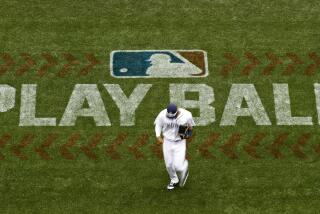FOR
- Share via
Few ideas arouse so much passion that opponents would enlist their own kids in the campaign against it. And realignment, frankly, didn’t figure to be one of them. But don’t try telling that to Mike Cahill.
Several times in the last few weeks, the financial planner from Chicago took a day off work and his young son, James, gave up a day of vacation to pound the pavement outside Wrigley Field. Each time, they walked from one side of the ballpark to the other, Mike handing out the pamphlets and James carrying the sign on which their message was written: “Keep the White Sox out of the National League.”
No one knows yet which realignment plan--if any--will emerge from this week’s meetings in Atlanta. But already the forces of tradition-for-its-own-sake are lining up against it.
Never mind that any plan would be an improvement over what baseball has in place at the moment. And never mind that most versions of realignment would help nearly every team cut costs, reduce travel times and--most important--snag more and better time slots in their local broadcast markets. The anti-realignment people are doing what the powers-that-be did centuries ago when Galileo said he could prove the earth revolved around the sun, instead of the other way around: They are dismissing the whole thing as heresy.
How shortsighted. The world has changed and, more important, the economics that shape baseball’s world has changed even more. The game has been super-sized, from eight teams a few generations ago to 30 and more by the time the next generation tunes in. The bills are sizable, too. Baseball needs to get its revenue stream flowing faster.
In a perfect world, realignment would restore the cozy version of baseball that existed before expansion, before free-agency, before endless schedule permutations made it impossible to keep track of who was in contention and which games mattered in which race.
“Our object here is to bring back the old days of the game where you played more games during the season against your division rivals,” said Boston Red Sox executive John Harrington, who doubles as chairman of the Realignment Committee. “Those games are more meaningful because they have double the impact on your standings.”
Naturally, traditionalists will grouse that trying to recapture only some pieces of the game’s grand past is not enough. Left to their own devices, they would go back to 154-game schedules, pull up all the carpets, have the designated hitters thrown into deep wells and the players back in wool uniforms, speaking in homilies and spitting up tobacco juice after every other word. The whole nation would be traveling once more by train.
Some of those things would definitely be an improvement. The pace of daily life, for instance. But there is no going back on some things.
Baseball, as enduring as it has proven itself to be, has to think about going forward instead of back. Traditionalists are always crying about the game turning its back on its history loving fans. But it’s not like those history loving fans have been making the turnstiles spin in recent years, either. Otherwise the owners, by and large traditionalists themselves, would not be messing with the game. And, at least as it applies to the game on the field, realignment leaves everything intact.
Yes, there are some lines that should not be crossed. If the names of the divisions are going to be changed, they should go from “National” and “American” to “East, “West,” and “Central.” No honorariums for Bud Selig, Jerry Reinsdorf, Bowie Kuhn, Happy Chandler or anyone else.
There’s no question where the fans are on this issue. They vote with their wallets and the vote on the product, as constituted at the moment, is “no.” The truth is that realignment is not the solution. It won’t end the backsliding, not by itself, anyway.
Anybody who doubts this hasn’t seen the competition lately. Surf every channel on your cable system. Start up your computer. Turn on the kids’ video system and drop a game cartridge in. Then try all three at once.
If baseball wants to break into that circle, it needs more kids playing the game again, not picketing it.
More to Read
Go beyond the scoreboard
Get the latest on L.A.'s teams in the daily Sports Report newsletter.
You may occasionally receive promotional content from the Los Angeles Times.










